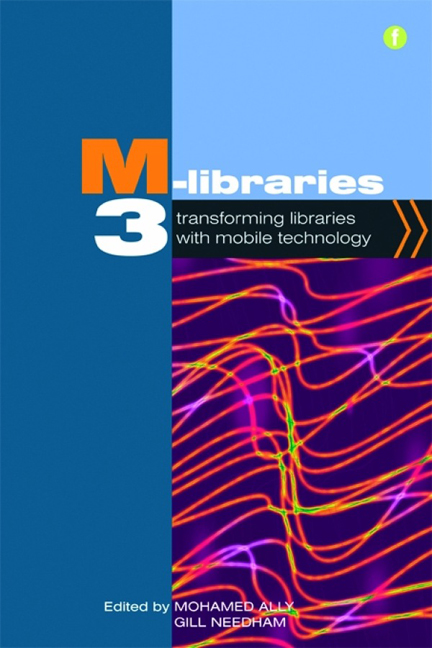Book contents
- Frontmatter
- Contents
- Acknowledgements
- Contributors
- Foreword
- Introduction
- 1 Education for all with mobile technology: the role of libraries
- PART 1 DEVELOPING MOBILE SERVICES
- PART 2 PEOPLE AND SKILLS
- PART 3 FOCUS ON TECHNOLOGY
- 15 Mobile services of the National Library of China
- 16 India's mobile technology infrastructure to support m-services for education and libraries
- 17 Use and user context of mobile computing: a rapid ethnographic study
- 18 Meeting the needs of library users on the mobile web
- 19 Mobile dynamic display systems for library opening hours
- 20 Device-independent and user-tailored delivery of mobile library service content
- 21 Designing effective mobile web presence
- Conclusion
- Index
18 - Meeting the needs of library users on the mobile web
from PART 3 - FOCUS ON TECHNOLOGY
Published online by Cambridge University Press: 08 June 2018
- Frontmatter
- Contents
- Acknowledgements
- Contributors
- Foreword
- Introduction
- 1 Education for all with mobile technology: the role of libraries
- PART 1 DEVELOPING MOBILE SERVICES
- PART 2 PEOPLE AND SKILLS
- PART 3 FOCUS ON TECHNOLOGY
- 15 Mobile services of the National Library of China
- 16 India's mobile technology infrastructure to support m-services for education and libraries
- 17 Use and user context of mobile computing: a rapid ethnographic study
- 18 Meeting the needs of library users on the mobile web
- 19 Mobile dynamic display systems for library opening hours
- 20 Device-independent and user-tailored delivery of mobile library service content
- 21 Designing effective mobile web presence
- Conclusion
- Index
Summary
Introduction
The Open University (OU) UK is a world-leading distance learning institution and currently has more than 240,000 students studying various undergraduate and postgraduate courses. Since 2005 a growing number of students have been accessing the University's websites on web-enabled mobile devices. In order to meet their requirements we endeavour to ensure that the content and services on the Library website are accessible and render well on smaller screens.
We developed the first mobile version of the Library website in 2007 (Sheikh and Tin, 2007), working collaboratively with Athabasca University using its ADR (Auto Detect and Reformat) software. This version was a single-column design intended to work on basic mobile phones as well on smartphones such as the Nokia N95. However, in the last couple of years our website analytics have shown an increase in numbers of visits from touch-screen phones (e.g. iPhone, HTC Android and Samsung Galaxy), which has prompted us to redesign the mobile Library website to improve usability, especially on touch-screen mobile devices. We are adapting MIT's open source Mobile Web project, which enables the website design to be optimized for three categories of smallscreen devices: basic, smart and touch-screen phones.
In this chapter we will highlight some of the developments to the mobile Library website and the work being carried out during different stages of the project, specifically covering:
■ gathering user requirements for mobile library services through user feedback, focus-group consultation and website analytics
■ a technical overview of adapting and customizing MIT's open source mobile web software
■ the lessons learned and key problems when designing content/websites for smaller screens.
The importance of mobile services for distance learners
An increasing number of OU students are now equipped with access to mobile technologies such as mobile phones and small-screen hand-held devices. These mobile technologies include anything from basic phones to the latest touch-screen phones, small-screen tablets and e-book readers. The majority of these devices are web-enabled and thus provide students with always-on access to the internet. We anticipate this leading to an increasing demand for flexible content delivery and library services that can meet the perceived needs and expectations of students using such mobile devices. Mobile technology applications in education can benefit both students and educators.
Mobile Library website development
In order to meet the needs of our mobile users, we have been developing and enhancing our mobile Library services during the last few years.
- Type
- Chapter
- Information
- M-Libraries 3Transforming libraries with mobile technology, pp. 159 - 170Publisher: FacetPrint publication year: 2012
- 2
- Cited by



